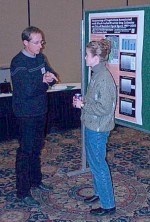The Shortgrass Steppe (SGS) LTER project, along with the USDA-ARS, the USFS Pawnee National Grassland and the Colorado State University Agricultural Experiment Station sponsored the 6th Shortgrass Steppe Symposium on January 10, 2003, in Fort Collins, Colorado.
One of the main goals of this year’s symposium was to create opportunities for collaborations between the research community and others interested in or working on issues concerning the conservation or management of the SGS.
Keynote talks were given by Greg Gamble and Steve Kettler of The Nature Conservancy of Colorado, “Biodiversity Conservation in the Western High Plains” and Ken Morgan of the Colorado Division of Wildlife, “Species Conservation on Private Lands.”
Each keynote talk was followed by a poster session and a discussion. Since we were specifically seeking areas for future collaborations, the discussions focused on how basic and applied aspects of research fit into conservation efforts, and the relationships between research, land use and management issues facing the SGS.
Approximately 90 people attended the symposium, including five high school students from eastern Colorado, who presented several posters of their research. Twenty-six posters were presented covering research studies, conservation, land management, information management, schoolyard LTER, and the GK-12 partnership program.
Although it is too early to measure success of the formation of collaborative projects, many email addresses were exchanged and several of the contacts made at the symposium have been continued over coffee and at CSU seminars.
We will keep the LTER community updated on how our relationships with conservationists and land managers develop.
| Posters presented at 6th Shortgrass Steppe Symposium, January 10, 2003 |
|

 Enlarge this image
Enlarge this image